Evergreen coniferous plants are considered the main decorative elements of various garden compositions and landscape design. Today, many gardeners use a wide variety of coniferous bushes and trees, which all year round do not lose their decorativeness, besides, these cultures are quite simple in care. Of the entire variety of coniferous plants, a cypressist is especially allocated, which is often confused with a cypress - a thermal-loving culture, which is quite difficult to grow in Russia. Cypress Tupoliste Nano Grazilis is one of the brightest representatives of the kind, which strikes its fairly spectacular and amazing appearance. The main advantage and decoration of this cypress woman is considered to be a beautiful needle, which is twisted on the similarity of the shells and gives an attractive appearance to the whole plant.
In this article, we consider the features and morphological description of the cypressovka Nana Grazilis, we note the basic options for using a coniferous plant in landscape design. We give the most important rules and nuances of the agricultural equipment of the cultivation of the cypressian of this variety.
Features and morphological description of cypressovka Nana Grazilis
The cypressovik is considered the most common coniferous plant, which is simply a great popularity of gardeners and landscape designers around the world. This is due to a beautiful and spectacular appearance, as well as light and openwork cheese. Cypressian is a perennial, coniferous, evergreen plant, which belongs to the family of cypress. Quite often this culture is confused with cypress, which can speak about these two plants. From his southern relative, the cypressovik is characterized by more flatbed branches, small bumps with another structure.
Kiparisovik Nana Grazilis is a representative of one of their 7 available species of this plant - a cypressovka of stupid or tupoliste. It is worth noting that because of its rather original appearance, this grade of a coniferous plant is simply enormous popular with landscaped designers who use the cypressian Nana Grazilis in creating a spectacular landscape. This is a coniferous plant, as many other representatives of the genus, in culture began to be used by about the 18th century. The territory of East Asia is considered a natural habitat area, namely Japan, where this type of cypressive prefers to settle in the mountains in the conditions of high humidity.
The cypressovik Nana Grazilis is a coniferous plant, which due to its appearance contrasts quite strongly with other species and varieties of this kind, since such twisted needles in the form of shells are no more than any plant. In addition, the shape of the crown of this variety, unlike other varieties of cypressovik, is wide and not quite correct.
Description of cypressovika Nana Grazilis:
- Cypressian stupid Nana Grazilis is an evergreen, a perennial, coniferous dwarf tree, which has a high decorative value.
- The root plant of the plant is quite powerful and strongly branched, a large number of roots depart from the central root. At the same time, the roots are located in the surface layer of the soil.
- Croon in a cypressive can vary from strictly cone-shaped to an asymmetric, which can go into a widely cone-shaped and even egg-shaped.
- The village itself is formed by short escapes that have a wavy-twisted form. The branches are covered with smooth, reddish-brown bark. The shoots of the plant are located very thick and their appearance resemble beautiful slightly twisted seashells.
- An adult plant of cypressovka this variety can reach height as 5 meters as much as possible, but most often in the garden you can grow a cypressian Nana Grazilis height of 2-3 meters. In the width of the village grows about 1.5-2 meters.
- The plant has a very slow growth. For the year, the decorative cypressive can grow only 5 cm in height and 3 cm wide. It is worth noting that by 10 years the evergreen plant will reach only 50 cm.
- The needle of the cypressian Nana Grazilis is brilliant, very soft to the touch, scaly. It lies very tightly on shoots, which allows you to form such beautiful twisted branches.
- Tint of needles can vary from salad to dark green, which depends first of all, from planting plants. The length of the needles can reach about 1.5-2 cm.
- At the end of the summer or at the beginning of the fall, cones are beginning to be formed, which are significantly less than that of cypress, and contain only two winged seeds.
- This type of cypressive needs very attentive care. For its full growth, fertile, wet soil is required.
- The plant does not tolerate drought, but it can withstand cold and frost. Winter hardiness of the cypressian Nana Grazilis refers to the climatic zone 6, which corresponds to frosts in minus 18-23 degrees. Young plants need shelter from frost.
- This type is characterized by the fact that it needs only in the rejuvenating trimming, form the crown every season is not necessary, since the coniferous plant grows extremely slowly.
Using a cypressian Nana Grazilis in Landscape Design
Cypressian Nana Grazilis is perhaps the most decorative and beautiful variety of this kind, which often choose gardeners and landscaped designers to decorate household plots. This evergreen coniferous plant in Western Europe enjoys particularly popular and love, where it is used everywhere in creating unusual compositions. Consider the most popular options for using a cypressian of this variety in the landscape.
- First of all, this plant looks great in single landings on the background of lawn.
- Many gardeners prefer to grow it in group landings, where a wide variety of coniferous cultures are simultaneously used. In this case, plants of different height are used to create a beautiful composition. This cypressive variety can be both in the foreground and be the background for lower plants.
- In addition, the plant can be planted together with other decorative deciduous cultures, as well as perennial colors. In this case, the green cypressian can perform the background for flowering plants.
- Cypressian Nana Grazilis can be used on the Alpine rolsters, in rockers and mixlers, as well as in stony and Japanese gardens.
- The cypressian of this variety is a low-volume plant, so it is great for growing in garden vases and containers. With this landing, the vases can be placed on the site, they can be decorated with a terrace or a gazebo, as well as a balcony. In addition, bright bonsai trees can be made from this coniferous culture.
As can be seen from the above options, the use of the cypressian Nana Grazilis is quite diverse and creates a space for the work of gardeners and designers on the way of creating beautiful and unique garden compositions.
The breeding of the cypressian Nana Grazilis: the most common ways
The cypressive of any variety is a valuable addition of any landscape, since this plant fits perfectly into any garden composition. It's not so difficult to grow in your site the cypressovik Nana Grazilis is not so difficult. Saplings of this plant stand in the store quite expensive, so you can purchase one, then use the reproduction to get more instances. Dwarf cypressian of this species can be multiplied by the following ways: seed reproduction and stalling. Consider the main features and rules of each breakdown option.
Seed reproduction
- This method of reproduction is extremely rarely used to multiply the varietal varieties of cypressovik, however, it is also possible to obtain quite strong and beautiful plants that have greater resistance to climate. However, when choosing a reproduction with seeds, it is worth considering that most of the varietal signs are not preserved and in the end you can get a plant with a completely unpredictable appearance.
- For such reproduction, first of all it is necessary to collect seeds. At adult bushes of cypressovka, wait for the full ripening of the cones, in which two seeds are located. It is important to have time before the flakes of the bumps will be revealed and the seeds will scatter.
- After collecting seeds you need to dry. Do it in a warm and well ventilated room.
- Cypress seeds have a very good germination, which is not lost up to 15 years. Therefore, planting material can be collected for the future.
- Seed seeds in autumn in open ground or after stratification into containers.
- Strategy seeds can be stratified in a fridge in a refrigerator or in a container that is cheered by snow. To do this, suitable containers are filled with light and nutritional soil, sand and peat can be used.
- After about a couple of months, the boxes are transferred to the house, where, at room temperature, the seeds begin to deteriorate and gradually grow. For the process of germination, seeds require a temperature of 3 degrees.
- When sprouts appear on the surface, planting containers can be transferred to bright, but a place protected from direct sunlight.
- Care for seedlings is regular watering and removal of weeds.
- When seedlings are fixed enough and they will have 2-3 sprouts, they can be seen in separate pots or immediately on a specially designated bed in the open ground.
- Kiparisovik Nana Grazilis, obtained from seeds, it is necessary to grow in the open soil for several years, covering it for the winter to a permanent place a young coniferous plant is transplanted only after 5-6 years.
Pencornia reproduction
- This method of breeding is used by gardeners much more often, as it is easier and fast and is distinguished by reliability. As a result, you can get at the same time a large number of high-quality seedlings with all varietal signs.
- The reproduction process is best to spend in spring time so that the seedlings do to root.
- First of all, it is necessary to prepare cuttings. For this spring, after the last frosts will be afraid, select strong and healthy shoots on the cypressics of Nana. It is best to use not old shoots. The length of each cutter should be approximately 10-15 cm.
- Experienced gardeners are recommended to cut off or simply tear cuttings with a "heel", which will allow the landing material faster to put roots. After that, remove all the cheese from the bottom of the cuttings.
- You do not need to process additionally.
- Next, it is necessary to prepare containers or pots, which are filled with nutrient soil and are abundant. After that, cuttings are rooted into the soil, and the pots are covered with a film to create a greenhouse effect.
- The rooting of cuttings occurs about 2 months, during which the landing should be regularly water and ventilated.
- In the future, the rooted cuttings need to land on a special bed, where each plant is covered on top of a plastic bottle.
- Before the onset of cold weather, all the cuttings are normally rooted and coming up, so they can simply cover them in the open ground, without transferring landing into the house.
- In the future, it is recommended to leave a cutting cutlery for a couple of years, after which the seedlings obtained are planted at a permanent place.
Planting a cypressian Nana Grazilis - Phased description
Landing and care for the cypressovik Nana Grazilis is no different from the cultivation of other varieties of this evergreen culture. It is enough to properly prepare and put the landing and coniferous beauty will delight you with a spectacular appearance. Consider more in more detail all stages of preparation for landing and actually the process of planting seedlings in open ground.
Stage 1. Selection and purchase of planting material
- First of all, each gardener needs to purchase high-quality and healthy seedlings. Alternatively, you can sell the planting material yourself using propagation methods.
- You can buy cypressovik Nana Grazilis in any specialized garden center or a nursery that is professionally engaged in breeding plants. In this case, you will be sure that you get the sapling specifically this cypress man.
- Do not buy landing material from roads or in natural markets. Here are the probability of being deceived and get absolutely not the seedlings.
- Experienced gardeners are recommended to buy a watering plant of the cypressovka of Nana Grazilis with a closed root system in containers. In such plants, the root system is stronger and less damaged, moreover, such seedlings are much faster and adapt to climatic conditions.
- Before buying, be sure to carefully inspect the top of the seedling. The needles and shoots should be strong and elastic, they should not be visible signs of disease and damage, there should be no yellowed sections. You can check the condition of the seedling and its root system simply turning the container down by the plant. If the seedlock sits tightly, it means that the care was good.
Stage 2. Choosing a place for planting a cypressian Nana Grazilis
- At the next stage, it is necessary to choose the optimal place for planting a cypressian Nana Grazilis.
- This kind of coniferous plant prefers to grow on an open solar or slightly pronted areas. When landing a cypression of any variety should stick to one rule: the greater the crown of the plant is yellow, the more lighted area it is necessary to select. At the cypressovka Nana Grazilis crown of a saturated green shade, so it can be planted in a small shadow.
- Do not forget that this plant prefers to grow on the elevated areas, so avoid low-rise where cold air and moisture can be stated.
- It is necessary to pick up a landing area protected from strong wind and drafts.
- When choosing a landing site, it is necessary to focus on the planned garden composition. Since this plant is low, it is possible to plant it as a curb culture, in single and group landings. Seedlings can also be seeds and gardens and vases.
Stage 3. Choice and soil preparation for landing
- Next, it is necessary to take care of the optimal composition of the soil for landing, since the cypressian of this variety is considered a plant rather demanding in this matter.
- Cypressian Nana Grazilis prefers to grow on fertile and nutritious soil, it is desirable to pick up loams.
- In addition, the ground in the landing site should be breathable and easy.
- Do not forget about the drainage of the soil, since this plant does not take out the moisture of moisture in the roots.
- Before boarding, it is important to carefully switch the site about 1 bayonet shovel, remove all weeds and their roots, break the soil and dissolve.
Stage 4. The process of planting a cypress woman Nana Grazilis - Step-by-step instruction
- The best time for planting seedlings of Cypress Nana Grazilis to open ground is spring, or rather, April, when the soil has already woke up and stopped.
- First of all, you need to take care of the preparation of landing holes. It is recommended to do this in the fall before the winter attack so that the soil has managed to settle.
- Landing pit for cypressovka should be rather big - 50-60 cm in width and 80-90 in depth. At the same time, if you land several seedlings nearby, do not forget about the distance between individual plants. In this case, it is necessary to represent what scale is already an adult coniferous plant. On average, such a distance should be approximately 1 meter and more.
- At the bottom of each landing point, it is recommended to place a drainage layer, which should be approximately 15-20 cm. You can use broken bricks as a drainage, grainzit, small gravel.
- Next, you need to prepare a nutritious substrate for planting seedlings. It should consist of three parts of the turf, three parts of humoring, two parts of the peat and one part of the sand. All of these components are thoroughly mixed and falling asleep into the pit approximately half the volume.
- In this form, the pit is left for the winter, and in the spring they are already starting landing seedlings.
- Seedlings purchased in the nursery need to pre-hide to alleviate their extraction. Further, many gardeners are recommended to shed the root system along with an earthen-commercial growth accelerator.
- You need to add 300 grams of nitroammofos to the existing soil mixture.
- At the bottom of each pit, the cypress seedlings are placed and gently poured them with soil mixture so that the root neck of the plant is on the same level with the surface of the soil.
- After landing, young plants need to be pouring, and then to plunder soil.
- The rolling circle is recommended to be meditated to prevent the evaporation of moisture. The mulch layer should be at least 7 cm.
Agrotechnical cultivation of cypressovika Nana Grazilis: Secrets and nuances of care
The care for the evergreen plant of this species is quite simple and requires from gardener only compliance with all rules and conditions, as well as regular attention.
- Watering. This is one of the most important stages of the care of the cypressovik of this variety. The coniferous tree does not tolerate drought, so watering should be regular and abundant. On average, the adult plant needs to water 1 time per week, and young seedlings require more frequent watering - an average of 2-3 times a week. Under adult cypressovik Nana Grazilis, it is necessary to pour about 10 liters of water. In hot weather, cypressives need regular spraying. An adult plant sprayed once a week, and young bushes are almost every day.
- Loosening and mulching. Regularly after each irrigation, it is recommended to loose the upper layer of soil for saturation with oxygen roots. In addition, you need to regularly plunge fresh mulch. For this, sawdust, wood cortex or peat crumb. At the same time, followed that if there is a mulch, then it is necessary to reduce the amount of irrigation.
- Feeding Feed the cypressian of this variety is recommended by special complex fertilizers for coniferous plants. The first time the seedlings fertilize only two months after landing using half the norm for an adult plant. In the future, feeding makes every two weeks before the middle of the summer, after which the plant begin to cook for winter.
- Trimming. In early spring, it is imperative to engage in sanitary trimming, removing all damaged and broken shoots. Forming trimming of a cypressian Nana Grazilis do no need, since this plant grows very slowly. It is recommended to carry out the crown to carry out a strong thickening of the crown.
- Diseases and pests. The cypressovik of this species is relatively resistant to various pests and diseases. Sometimes they can start refusing roots, especially if you do not comply with the correct irrigation mode. From the pests most often harm the coniferous plant of the shield and a web tick, to fight with which you can with the help of insecticides.
- Preparation for winter. The plant needs to be prepared in advance for winter. To do this, in the middle of the summer cease to make fertilizers, the excess of which is significantly reduced by the frost resistance of the culture. In case of a minor winter, the rolling circle is recommended to spray peat and spruce legs. You can use observer material.
Cypressian Nana Grazilis - Photo
According to numerous reviews, the cypressovik Nana Grazilis is considered the most vivid representative of this family. This plant is simply a magnificent appearance, which is achieved by an unusual rolled cheese, similar to shells. However, despite the exotic species, landing and care for the culture is quite simple and forces by any gardener.

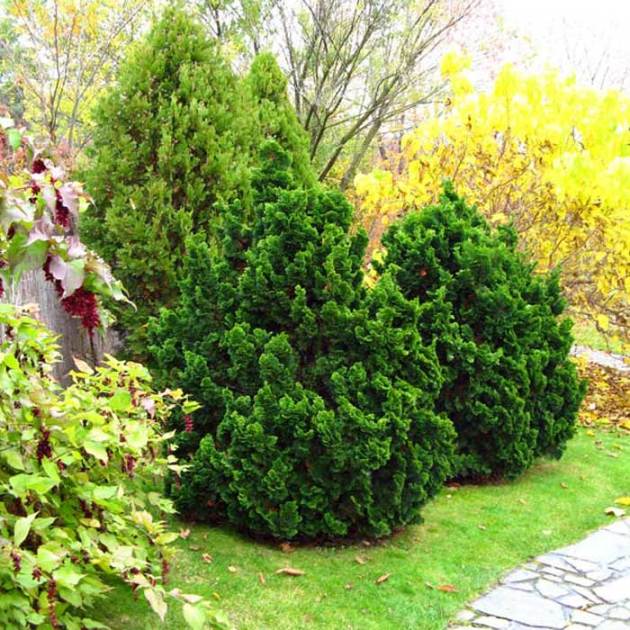
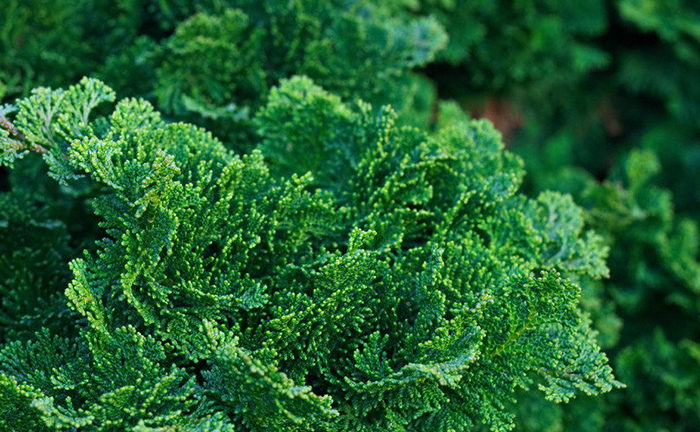
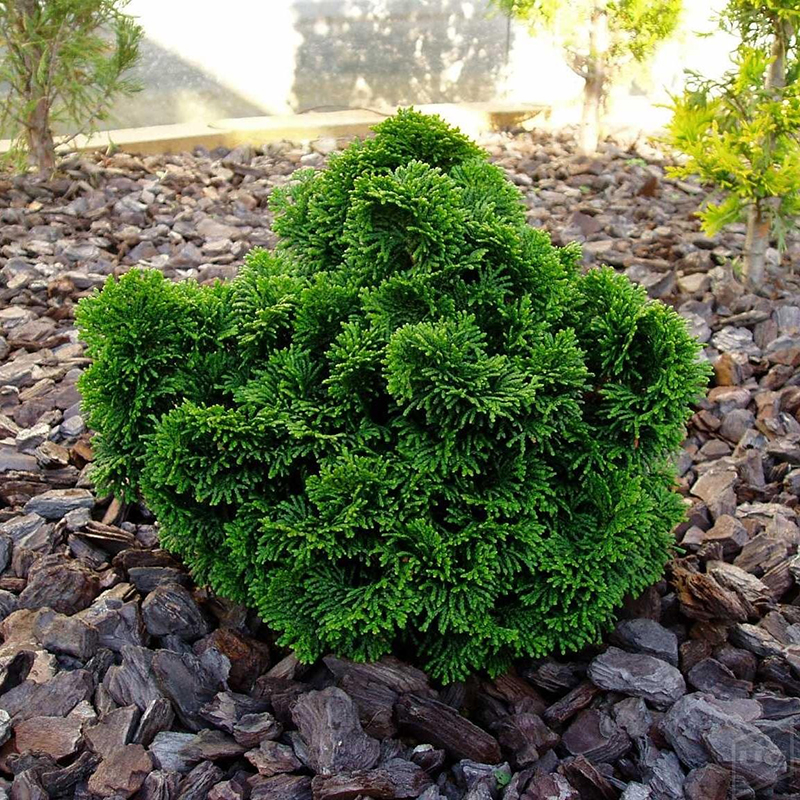
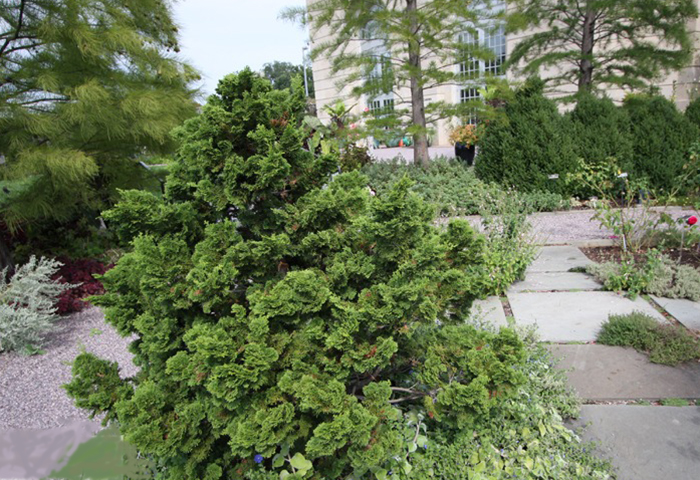
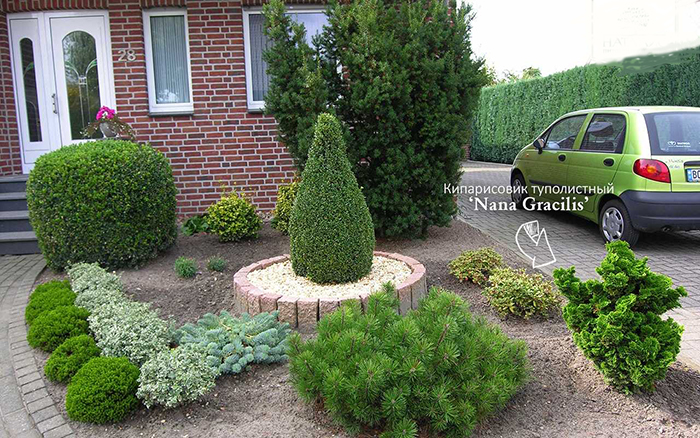
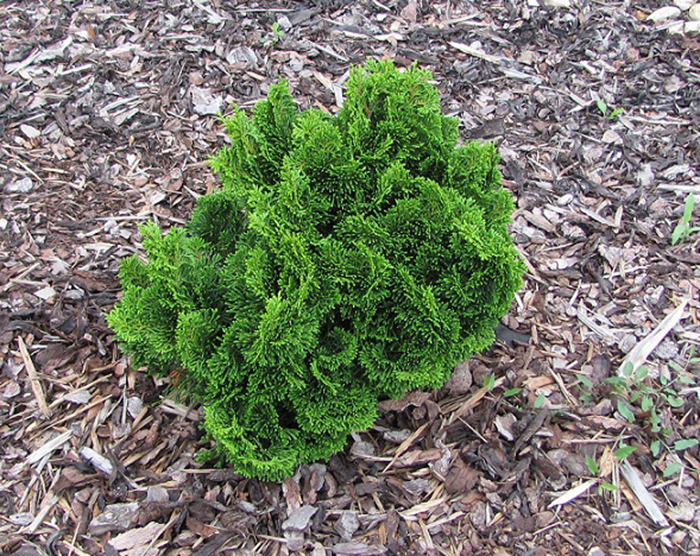
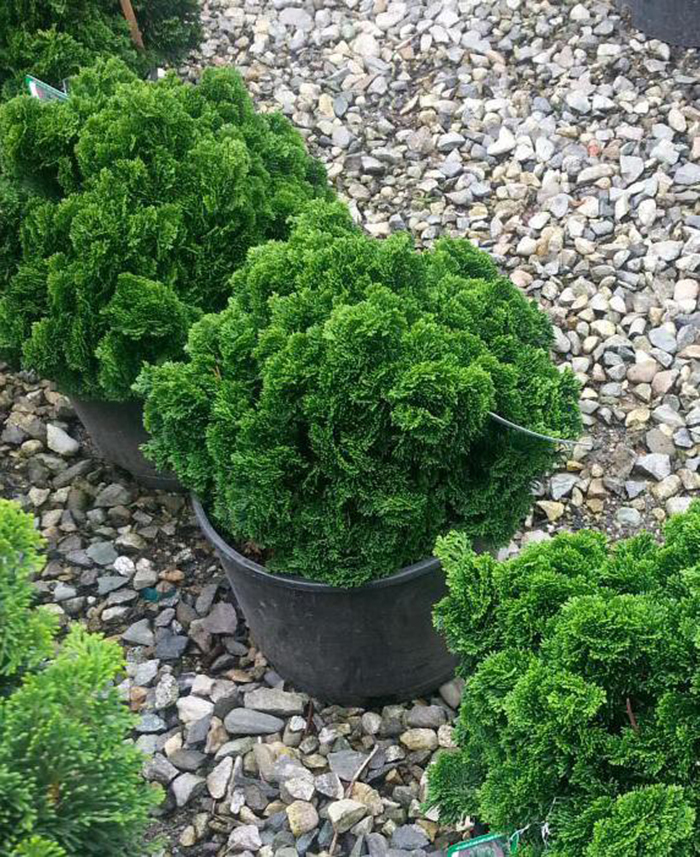
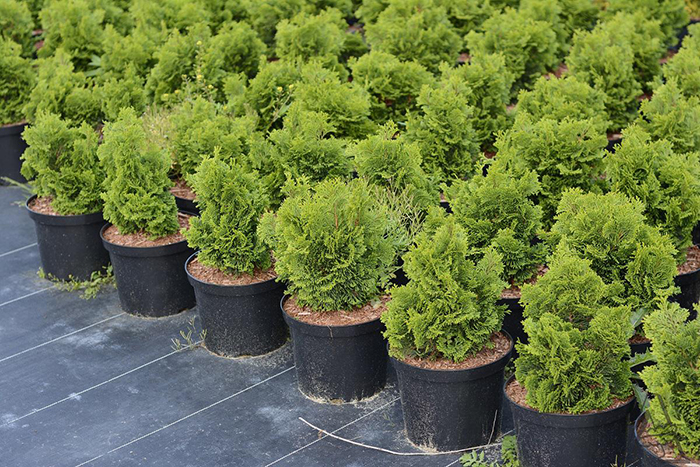
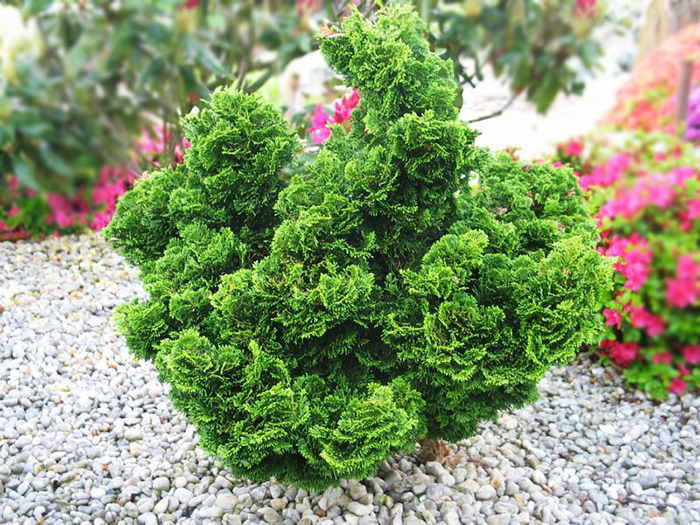
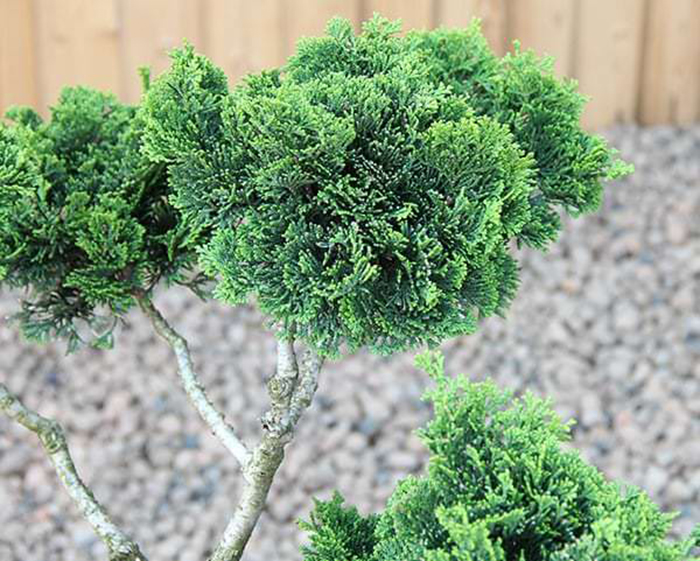
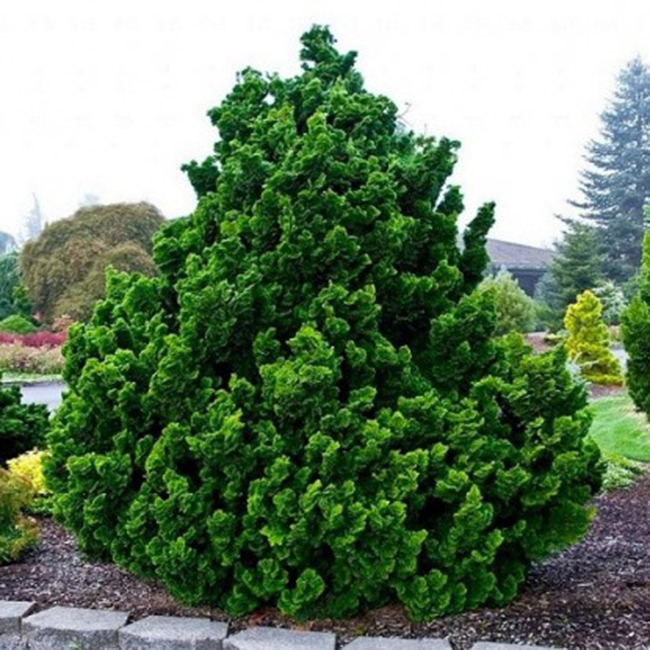
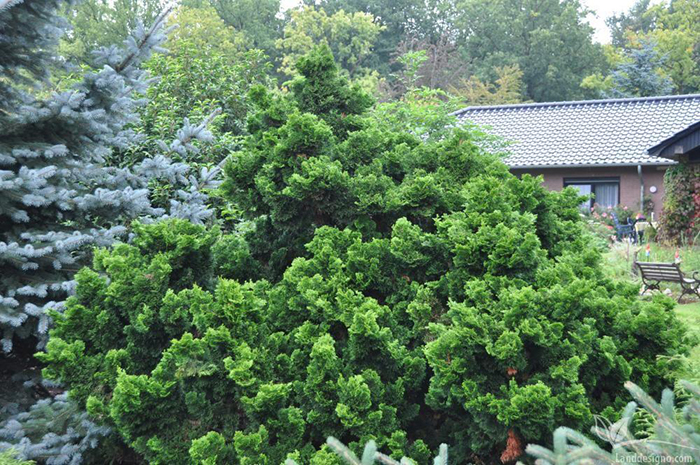
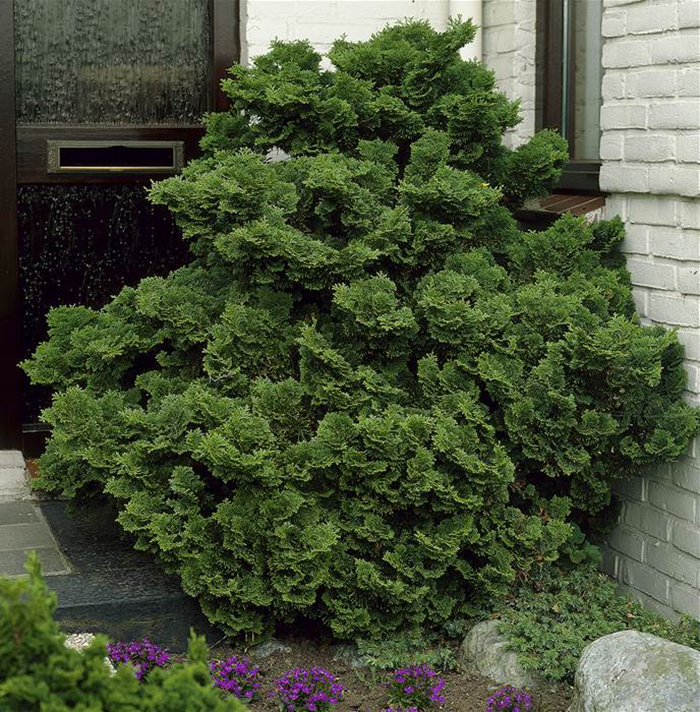
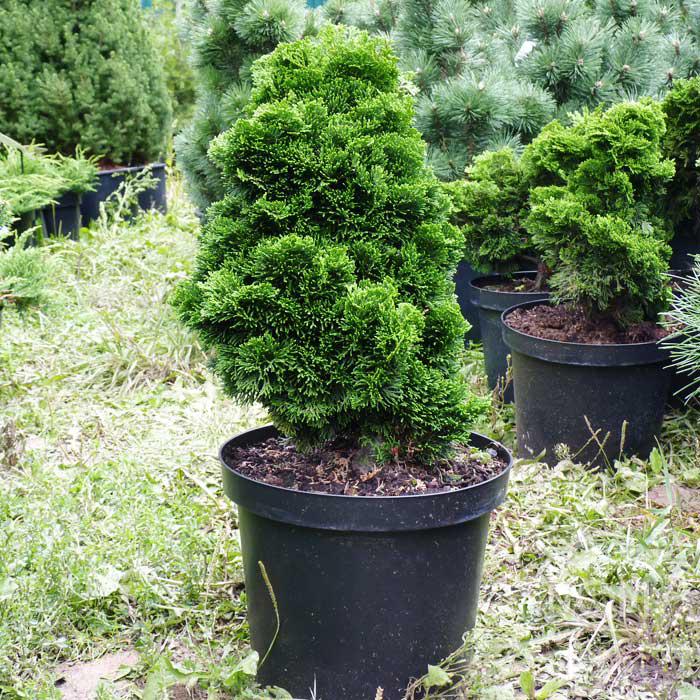












 Start a discussion ...
Start a discussion ...